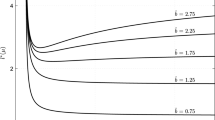Abstract
We study the effect of changes in flow speed on competition of an arbitrary number of species living in advective environments, such as streams and rivers. We begin with a spatial Lotka–Volterra model which is described by n reaction–diffusion–advection equations with Danckwerts boundary conditions. Using the dominant eigenvalue \(\lambda \le 0\) of the diffusion–advection operator subject to boundary conditions, we reduce the model to a system of ordinary differential equations. We impose a “transitive arrangement” of the competitors in terms of their interspecific coefficients and growth rates, which means that in the absence of advection, we have the following situation: for all \(1\le i<j\le n\), species i out-competes species j, while species j has higher intrinsic growth rate than species i. Changing advection speed in the original spatial model corresponds to changing the value of \(\lambda \) in the spatially implicit model. Considering the cases of the odd and even n separately, we obtain explicit intervals of the values of \(\lambda \) that allow all n species to be present in the habitat (coexistence interval). Stability of this equilibrium is shown for \(n\le 4\).







Similar content being viewed by others
References
Ballyk M, Smith H (1998) A flow reactor with wall growth. In: Horn MA (ed) Mathematical models in medical and health science. Vanderbilt University Press, Nashville, pp 17–28
Ballyk M, Dung L, Jones DA, Smith H (1998) Effects of random motility on microbial growth and competition in a flow reactor. SIAM J Appl Math 59(2):573–596
Gantmacher FR (1959) Applications of the theory of matrices. Interscience, New York
Lutscher F, McCauley E, Lewis MA (2007) Spatial patterns and coexistence mechanisms in rivers. Theor Popul Biol 71(3):267–277
Speirs DC, Gurney WSC (2001) Population persistence in rivers and estuaries. Ecology 82(5):1219–1237
Strohm S, Tyson R (2012) The effect of habitat fragmentation on cyclic population dynamics: a reduction to ordinary differential equations. Theor Ecol 5(4):495–516
Vasilyeva O, Lutscher F (2010) Population dynamics in rivers: analysis of steady states. Can Appl Math Q 18(4):439–469
Vasilyeva O, Lutscher F (2012a) Competition of three species in an advective environment. Nonlinear Anal Real World Appl 13(4):1730–1748
Vasilyeva O, Lutscher F (2012b) How flow speed alters competitive outcome in advective environments. Bull Math Biol 74(12):2935–2958
Acknowledgements
The author is grateful to Frithjof Lutscher for numerous helpful discussions and valuable suggestions on the subject of this paper. The author would also like to thank Pauline van den Driessche for helpful feedback after reading a preliminary version of this paper. Finally, the author thanks the two anonymous referees for many valuable and detailed comments.
Author information
Authors and Affiliations
Corresponding author
Rights and permissions
About this article
Cite this article
Vasilyeva, O. Competition of Multiple Species in Advective Environments. Bull Math Biol 79, 1274–1294 (2017). https://doi.org/10.1007/s11538-017-0285-2
Received:
Accepted:
Published:
Issue Date:
DOI: https://doi.org/10.1007/s11538-017-0285-2



